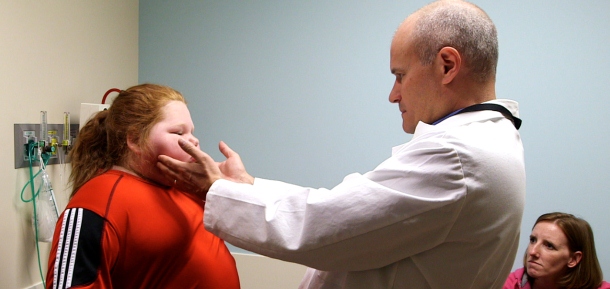As many of you were watching the details of Alexis Shapiro’s surgery unfold on Twitter (#HyObesity) last Friday, you might have been wondering about the benefits of the sleeve gastrectomy for patients with hypothalamic obesity.
This procedure surgically removes 75-80% of the patient’s stomach leaving only the inner curve of the stomach (the “lesser” curve), which permanently reduces its size.
The most notable and immediate impact of the sleeve gastrectomy is the major reduction in hunger and the major enhancement in satiety (that feeling of fullness) with only a very small meal, but other significant metabolic changes happen relatively quick after sleeve gastrectomy.
This is good news, especially as it pertains to type 2 diabetes. This progressive disease has devastating side effects, such as deterioration in blood flow to vital organs due to disease within the small blood vessels that supply the kidney, retina, feet, and heart. This reduction in blood flow can lead to devastating complications within the first decade after diagnosis, and can ultimately cause renal failure, blindness, amputations, and heart attacks. Thus it is important to get diabetes under control, and keep it under control, as quickly as possible.
Gastric bypass procedures have been clearly associated with reversal of diabetes as early as one-day post-surgery, wherein the patient’s insulin medications are stopped and blood sugars drop to acceptable levels. In fact, research has also shown that adults who undergo sleeve gastrectomy enjoy early (within months) and major improvements in type 2 diabetes following the sleeve procedure.
How is this possible? Even before the body has the opportunity to lose weight following sleeve gastrectomy, the procedure affects glucose metabolism, or the process of converting glucose into energy for cell utilization. This most likely has something to do with enhanced production of anti-diabetic hormones that come from the gut, and surgically-induced changes in the processing and handling of specific nutrients that may act as metabolic signals. This is a very exciting area of current research here in Cincinnati and elsewhere.
The other positive impacts of sleeve gastrectomy, which we expect to see very quickly after an operation, are reduction in weight and BMI, food cravings, and improvements in liver size. What is not known very well is how early and how lasting the positive effects of the sleeve gastrectomy on type 2 diabetes can be seen in young patients.
The goal is achieving a healthy weight and maintaining it. We participated in a study that showed weight loss of 20% in patients with hypothalamic obesity who received the gastric bypass or sleeve gastrectomy within the first twelve months post-surgery. But the sleeve gastrectomy patients seemed to be at higher risk for regaining some of that weight thereafter.
For some patients, surgeons may recommend a “staged” approach, which means that a sleeve is done initially and then it is converted to a gastric bypass. This is a decision that is usually made after the first months to one year, and would be based on a number of factors. These include not only weight loss success but success in durably reversing other major health problems as well. So close monitoring, counseling, encouragement, and compassion are important parts of the follow up care.
But for now, a 12 year old girl who within days of operation no longer needs insulin or any other diabetes medication, and has no signs of type 2 diabetes at all, is taking big steps in the right direction.






[…] “There was no sign of her diabetes 24 hours after the surgery,” said Dr. Thomas Inge, the doctor in charge of Alexis’ care at Cincinnati Children’s Hospital Medical Center (he explains how this is possible on the hospital’s blog). […]